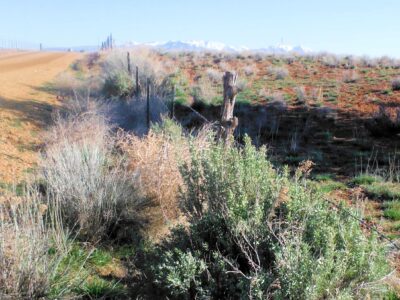 SAGEBRUSH: FOE
SAGEBRUSH: FOE
When my family first moved to Southwestern Colorado, our pastures were overgrown with sagebrush. At the time, we didn’t have the equipment to remove it quickly, so the only way to get rid of it was with a mattock. This was time-consuming, back-breaking work, that nobody liked, but it had to be done, because nothing much would grow near sagebrush. It produces a strong chemical that repulses most plants, animals, and insects, so up until recently, we considered it a noxious plant with no value.
SAGEBRUSH: FRIEND
Then I researched for the second book in my DESTINY trilogy. I read many journals and letters written by women who traveled the Oregon Trail between 1842 – 1850. One of the sights they always noted in their diaries was the miles and miles of sagebrush they had to travel through during a part of their journey. One woman described it as smelling like “camphor and turpentine.” One of the primary constituents of sage brush is camphor. The leaf essential oil is 400,000 parts per million (ppm). The next time you go to the grocery store, check out some of the sore muscle creams or gels. The ones I found had active ingredients of either menthol, camphor, or a combination of both.
 Because I have developed an interest in medicinal plants, and because one of the characters in my story is an unorthodox botanist-medical doctor, I wanted to see if sagebrush had any medicinal value. I was shocked. According to Michael Moore, author of Medicinal Plants of the Mountain West and Medicinal Plants of the Desert and Canyon West: A Guide to Identifying, Preparing, and Using Traditional Medicinal Plants Found in the Deserts and Canyons of the West and Southwest, sagebrush has great value.
Because I have developed an interest in medicinal plants, and because one of the characters in my story is an unorthodox botanist-medical doctor, I wanted to see if sagebrush had any medicinal value. I was shocked. According to Michael Moore, author of Medicinal Plants of the Mountain West and Medicinal Plants of the Desert and Canyon West: A Guide to Identifying, Preparing, and Using Traditional Medicinal Plants Found in the Deserts and Canyons of the West and Southwest, sagebrush has great value.
AS A COLD INFUSION
* surprisingly useful for impaired digestion and poor gum health, coated tongue, and chronic bad breath
* stimulates and excites gastric functions
AS A HOT HERB TEA (Be warned, it tastes terrible!)
* induces sweating in the earlier stages of a simple viral infection
* promotes secretions and loosens mucus in bronchial infections
AS A SIMMERING TEA or INHALANT
* eases pulmonary problems
* is a treatment for lingering sore throats that might border on strep
AS A COLD INFUSION, POULTICE OR TINCTURE
* applied to back and chest are useful to speed up recovery from bronchitis or influenza
* in a foot or hand bath, helpful for rheumatoid arthritis aggravated by cold
The leaves are also substantially antibacterial and antifungal.
 There were other things for which sagebrush was useful. It made me wonder if the emigrants had knowledge of this abundant, God-given plant, would as many of them have died on the trail from cholera and dysentery? To see the diseases of the Oregon Trail, click here.
There were other things for which sagebrush was useful. It made me wonder if the emigrants had knowledge of this abundant, God-given plant, would as many of them have died on the trail from cholera and dysentery? To see the diseases of the Oregon Trail, click here.
The author explains when the plant should be harvested, what parts are used for different treatments, and what cautions should be observed. After reading selections from these books, my whole perspective of the value of sagebrush has changed. Though we still don’t appreciate it growing in the wheat or alfalfa fields, others bushes are left to grow nearby.




 SPHERE OF INFLUENCE
SPHERE OF INFLUENCE
Another thought provoking story thank you for all the information. Can handle sage in small doses but the insect repellent is so true. Didn’t know it had healing properties will share with my Doctor.
I’m so glad you found the information to be helpful, Kelley. Researching for my novels has provided me with many opportunities to learn new information. Best wishes. Derinda